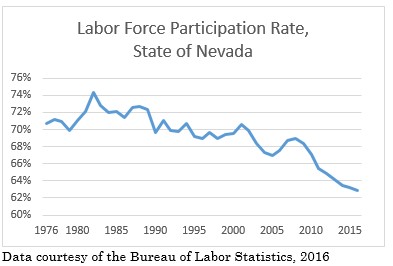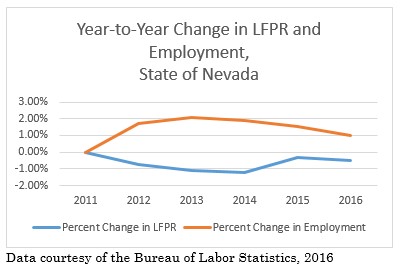Nevada’s Labor Force Participation Rate Has Never Been Lower
By Daniel Honchariw
Nevada’s Labor Force Participation Rate Has Never Been Lower
By many significant indicators, the national economy is in poor shape. In terms of how this has translated into Nevada’s economy, one troubling statistic concerns the size of the state’s labor force.
Nevada’s labor force participation rate is at 62.9 percent, an all-time low according to the Bureau of Labor Statistics. A corresponding decrease in the state’s unemployment rate appears to be a symptom of stagnation, not proof of economic recovery.
That’s because there are now more than 800,000 work-capable Nevadans who are altogether unwilling to look for work.
This situation has developed as a result of national economic policies which have thrust mountains of new regulations onto productive private businesses. Such policies have produced a weakest-on-record economic recovery following the 2008 financial meltdown.
Thus, while Nevada’s unemployment rate has fallen sharply versus its 2011 highs of more than 13 percent, Nevadans should take this perceived success with a grain of salt.

Between January 2011 and 2016, Nevada’s unemployment rate fell from 13.5 percent to 6.2 percent.
During the same period, however, the state’s labor force participation rate also fell steadily — and it continues to do so. This has some questioning whether the decrease in Nevada’s unemployment rate is being artificially boosted by a diminishing number of willing workers.
While the labor force participation rate and the unemployment rate both measure macroeconomic health, generally the two data points are actually quite different. The very nature of this difference means that a reduction in the labor force participation rate, ceteris paribus, can artificially inflate employment numbers. In turn, this may have the effect of portraying the economic landscape in a healthier context than reality might otherwise lend.
This is true because the unemployment rate only measures those who cannot find work among labor force participants. By definition, if you are neither employed nor actively looking for work, then you are not considered to be participating in the labor force.
To fully understand the impact this has on unemployment rates, it’s important to highlight the difference between labor force participants, and the labor force population.
The labor force population measures the number of civilian — non-institutionalized people ages 16 and older. At the start of 2011, Nevada’s labor force population was approximately 2,087,000; by 2016, that number had jumped to 2,280,000 — an increase of nine percent.
During the same five-year span, Nevada’s number of labor force participants increased from 1,364,000 to 1,433,000, a considerably-smaller proportional jump of five percent.
It is therefore easy to interpret a portion of Nevada’s decrease in the unemployment rate from 2011 as a predictable result of a mass migration from the labor force by former labor force participants.
Indeed, since 2011, Nevada’s unemployment rate has decreased in each of the five years. However, its labor force participation rate has decreased in each of those five years as well.

Unfortunately, this means that the data point used to highlight an allegedly strong post-recession recovery — a drop in Nevada’s unemployment rate — is actually a symptom of ongoing weakness in the economy.